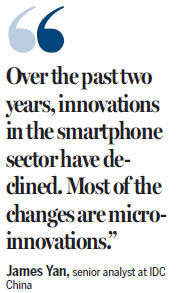Smartphone brands bring out the big guns in marketing war
Updated: 2015-09-30 08:05
By Zhou Mo in Shenzhen(HK Edition)
|
|||||||||
Smartphone maker ZTE Corporation made a splash last week after a photo went viral on Chinese micro blogging site Weibo.
The photo showed a ZTE Axon handset lying on a richly laid table over the invitation card to a banquet in Seattle to welcome President Xi Jinping, who began his first state visit to the United States on Sept 22.
Many interpreted it as a sign of support for homemade brands from the national leadership and saw it as a great way for the Shenzhen-based vendor to increase its popularity.
Axon is the flagship model designed for and developed in the US by ZTE, which is among only a handful of Chinese brands to have tapped the Western market.
According to market research organization IDC, ZTE became the fourth-largest smartphone producer in the US market in the second quarter of 2015, accounting for 8 percent of market share.
Competition between Chinese smartphone brands has reached white-hot intensity, with producers taking great pains to consolidate positions in the domestic market while striving to expand aggressively overseas.
As the gap in quality and price among the brands narrows, marketing has assumed vital importance, with many brands racking their brains to create an intriguing and effective strategy that can distinguish them from the rest of the field and boost the bottom line.

"Over the past two years, innovations in the smartphone sector have declined. Most of the changes are micro-innovations," said James Yan, a senior analyst at IDC China. "In this circumstance, the role of marketing becomes bigger."
Promotion with the help of national leaders is, of course, a good idea. But not every player is lucky enough to get that chance.
For newly emerging vendors, like Xiaomi and Meizu, the strategy of choice is taking advantage of the Internet to promote sales.
Social networking sites are a main battleground for Xiaomi. On Weibo, often dubbed the mainland Twitter, the Beijing-based vendor has more than 10 million followers. It also seeks to attract customers through the charm of the company's founder, Lei Jun, a celebrity in the IT industry who is followed by 12 million fans on the online platform.
The company also holds an online "Fan Festival" every year on April 8, when discounts and privilege schemes are offered.
"Xiaomi is good at interacting with its customers. Therefore, many of its marketing activities are based on this advantage," Yan said.
Xiaomi was crowned the leading vendor in the Chinese smartphone market in the second quarter of this year, with 15.9-percent share, according to a report by market research firm Canalys.
Second on the list with 15.7 percent of the market share was Huawei, which takes a different approach to marketing.
"Brands such as Huawei, and also ZTE, are focused on offline channels and like to promote their products on billboards in central business districts, airports, high-speed railway stations, and so on," pointed out Jessie Ding, research analyst at Canalys Shanghai.
Huawei has wide offline coverage and a number of channels, including retail and experience stores, according to its Chief Executive Officer for Consumer Business, Yu Chengdong.
"This is a major difference from other Internet companies and one of our advantages," Yu was reported as saying.
According to a survey by Paris-headquartered market research company Ipsos, the global brand popularity of Huawei rose to 65 percent in 2014 - up from 52 percent the previous year.
OPPO, VIVO and some other homegrown smartphone producers have also increased visibility and product recall by using the tool of media as well as celebrity endorsements.
OPPO's new product R7, which claims excellence in photo shooting, for instance, has a heavy presence on popular mainland TV programs Dad, Where Are We Going and The Voice of China.
The two programs are popular among young viewers in their 20s or early 30s, and Dongguan-based OPPO believes that the specific group it is targeting has a higher likelihood of being impressed by the device.
However, the plan could also backfire. Zuo Chen, 28, got to know about the new model from Dad, Where Are We Going. "Every time I watch the TV show, the advertisement of R7 is there," she said.
"The smartphone seems amazing with wonderful photo-taking function. But its frequent appearance on entertainment programs gives me a feeling that the product is more for entertaining than for practical use."
That is the hard fact facing Chinese smartphone producers - increasingly critical consumers with higher specs demands amid a rapidly saturating market.
Even international tech giants Apple and Samsung are finding the going far from smooth. The Canalys report shows that the two vendors fell to the third and fourth place, respectively, in terms of market share in the Chinese mainland's smartphone market over the second quarter this year.
sally@chinadailyhk.com
(HK Edition 09/30/2015 page9)